
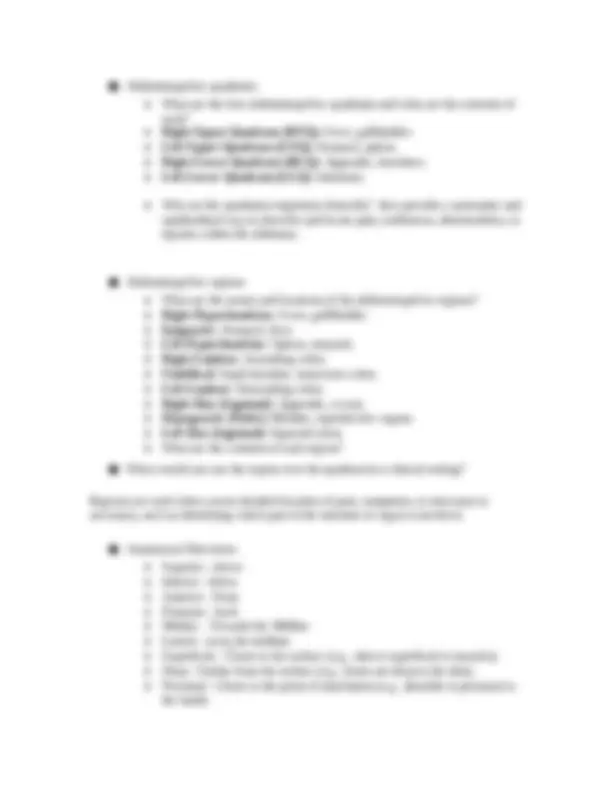
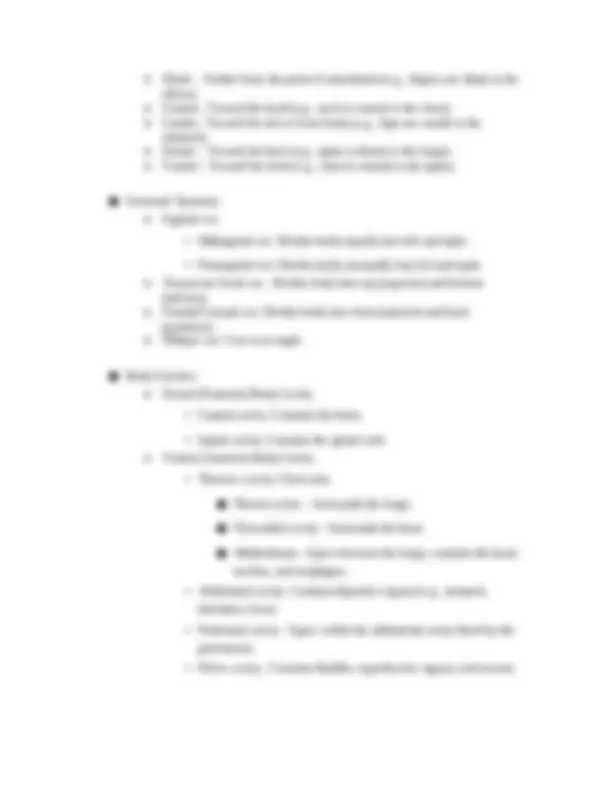
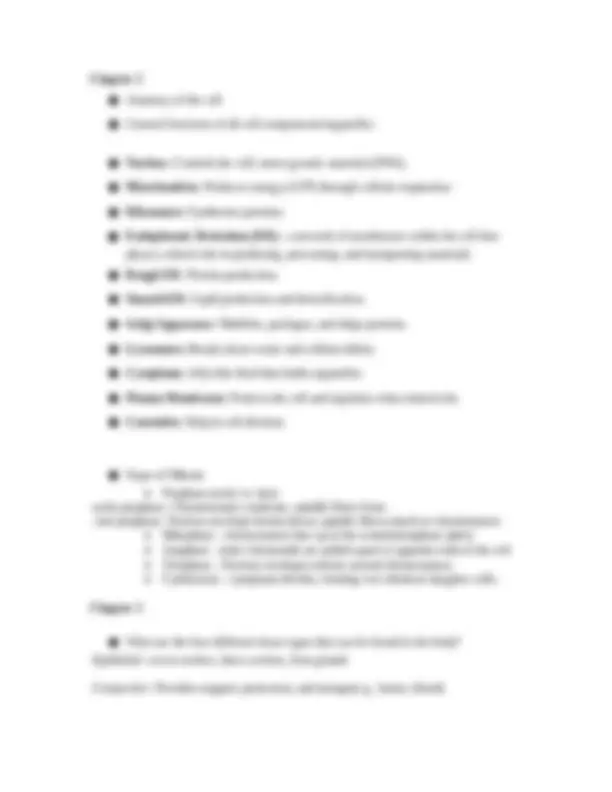
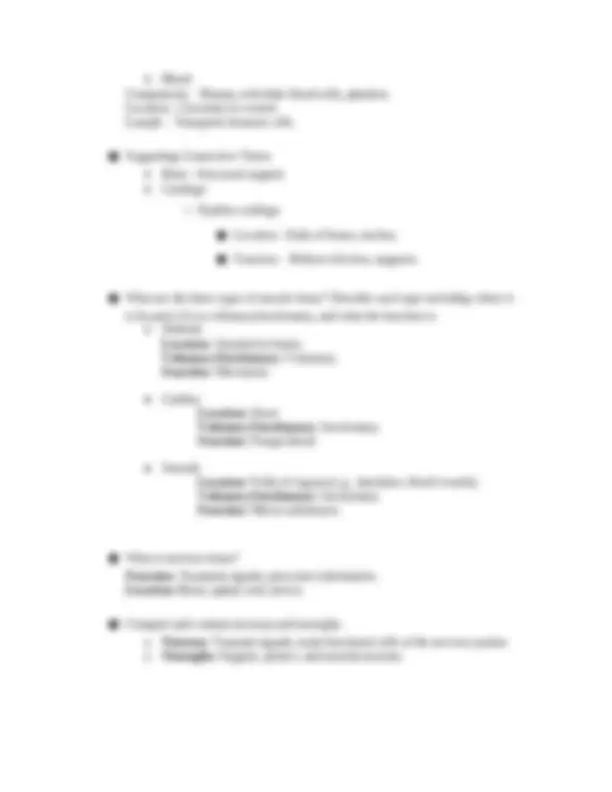
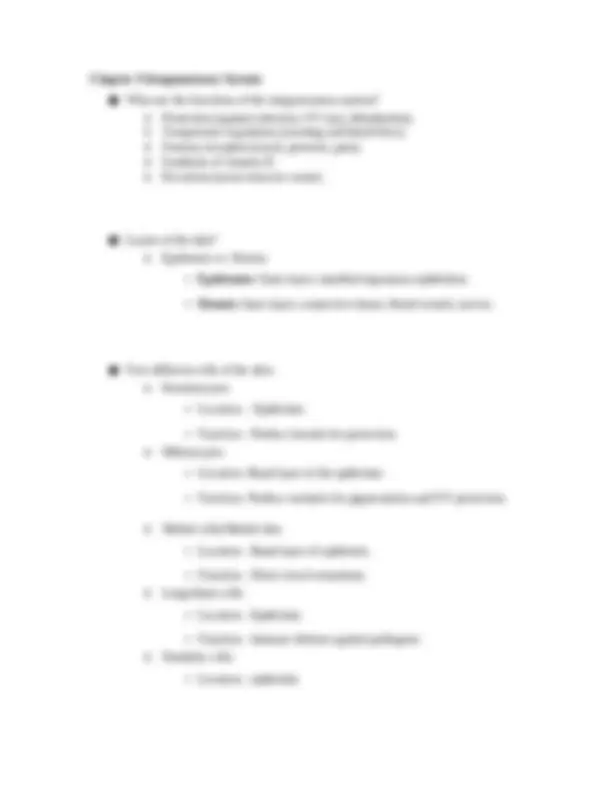
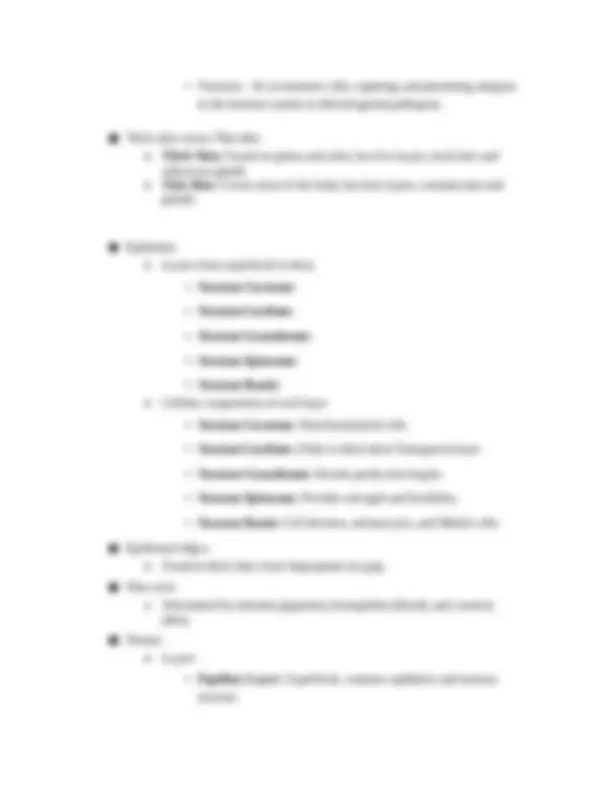


Study with the several resources on Docsity

Earn points by helping other students or get them with a premium plan


Prepare for your exams
Study with the several resources on Docsity

Earn points to download
Earn points by helping other students or get them with a premium plan
Community
Ask the community for help and clear up your study doubts
Discover the best universities in your country according to Docsity users
Free resources
Download our free guides on studying techniques, anxiety management strategies, and thesis advice from Docsity tutors
ANAT260 OL Week 1 Study Guide Chapter 1,2,3,4 West Coast 2025/2026/ANAT260 OL Week 1 Study Guide Chapter 1,2,3,4 West Coast 2025/2026
Typology: Assignments
1 / 11

This page cannot be seen from the preview
Don't miss anything!







Week 1 Study Guide ANAT 260 OL Blezinski Chapters 1, 2, 3, and 4 Chapter 1 ● Anatomy: Study of body structure. ● Physiology Study of body functions. ● Cytology: Study of cells. ● Histology: Study of tissues. ● Gross Anatomy: o Surface anatomy: Study of surface markings. o Regional anatomy: Study of specific body areas. o Systemic anatomy: Study of organ systems. ● Levels of organization: o Chemical/Molecular: This is the simplest level, involving atoms and molecules that make up the building blocks of cells. o Cell: The smallest functional unit of life, such as a muscle cell or nerve cell. o Tissue: Groups of similar cells working together, like muscle tissue (movement) or nervous tissue (signals). o Organ level: Structures made of multiple tissues performing specific functions, such as the heart (pumping blood). o Organ System level: Groups of organs working together, like the cardiovascular system (heart and blood vessels circulating blood). o Organism: The complete living being, where all systems work together to maintain life (e.g., a human). o What level is the most complex? organism o What level is the least complex? chemical/ molecular
● Understand the general functions & components of all the organ systems in the body o i.e. the heart, arteries, capillary beds, and veins are all part of the cardiovascular system and the CV system is responsible for pumping blood throughout the body delivering oxygen and nutrients to all the tissues. o General Function of the Cardiovascular System : The cardiovascular system is responsible for pumping blood throughout the body. This ensures oxygen and nutrients are delivered to all tissues. o Components of the Cardiovascular System : ▪ Heart : Acts as the pump that moves blood. ▪ Arteries : Carry oxygen-rich blood away from the heart to the rest of the body. ▪ Capillary Beds : Tiny blood vessels where oxygen and nutrients are exchanged with tissues. ▪ Veins : Carry oxygen-depleted blood back to the heart. In simple terms, this system is like a delivery service: ● The heart is the engine. ● Arteries are the highways that deliver oxygen and nutrients. ● Capillaries are the drop-off points where the delivery is made to tissues. ● Veins are the return route , bringing used materials back to the heart. ● Anatomical position (what is it?) o Supine vs. Prone Supine- lying face up Prone - lying face down ● Anatomical language/regions of the body o Cranial - skull o Oral - mouth o Orbit - eye cavity o Mental - chin o Buccal - cheek o Cervical - neck o Brachial - upper arm o Antecubital - front of the elbow
o Distal - Farther from the point of attachment (e.g., fingers are distal to the elbow). o Cranial - Toward the head (e.g., neck is cranial to the chest). o Caudal - Toward the tail or lower body (e.g., hips are caudal to the stomach). o Dorsal - Toward the back (e.g., spine is dorsal to the lungs). o Ventral - Toward the front (e.g., chest is ventral to the spine). ● Sectional Anatomy: o Sagittal cut: ▪ Midsagittal cut: Divides body equally into left and right. ▪ Parasagittal cut: Divides body unequally into left and right. o Transverse/Axial cut: Divides body into top (superior) and bottom (inferior). o Frontal/Coronal cut: Divides body into front (anterior) and back (posterior). o Oblique cut: Cuts at an angle. ● Body Cavities: o Dorsal (Posterior) Body Cavity ▪ Cranial cavity: Contains the brain. ▪ Spinal cavity: Contains the spinal cord. o Ventral (Anterior) Body Cavity ▪ Thoracic cavity: Chest area. ● Pleural cavity - Surrounds the lungs. ● Pericardial cavity - Surrounds the heart. ● Mediastinum - Space between the lungs; contains the heart, trachea, and esophagus. ▪ Abdominal cavity: Contains digestive organs (e.g., stomach, intestines, liver). ▪ Peritoneal cavity - Space within the abdominal cavity lined by the peritoneum. ▪ Pelvic cavity - Contains bladder, reproductive organs, and rectum.
Chapter 2 ● Anatomy of the cell ● General functions of all cell components/organelles ● Nucleus: Controls the cell; stores genetic material (DNA). ● Mitochondria: Produces energy (ATP) through cellular respiration. ● Ribosomes: Synthesize proteins. ● Endoplasmic Reticulum (ER): a network of membranes within the cell that plays a critical role in producing, processing, and transporting materials. ● Rough ER: Protein production. ● Smooth ER: Lipid production and detoxification. ● Golgi Apparatus: Modifies, packages, and ships proteins. ● Lysosomes: Breaks down waste and cellular debris. ● Cytoplasm: Jelly-like fluid that holds organelles. ● Plasma Membrane: Protects the cell and regulates what enters/exits. ● Centrioles: Help in cell division. ● Steps of Mitosis o Prophase (early vs. late) -early prophase: Chromosomes condense; spindle fibers form
● Simple Squamous Epithelium o Location: Lungs, blood vessels. o Function: Diffusion, filtration. ● Stratified Squamous Epithelium o Location: Skin, mouth. o Function:Protection. ● Simple Cuboidal Epithelium o Location: Glands, kidney tubules. o Function: Secretion, absorption. ● Simple Columnar Epithelium o Location: Stomach, intestines. o Function: Absorption, secretion. ● Pseudostratified Ciliated Columnar Epithelium o Location: Trachea, respiratory tract. o Function: Moves mucus. ● Transitional Epithelium o Location: Bladder. o Function: Stretching. ● What are the components of connective tissue? -Cells, fibers (collagen, elastic, reticular), ground substance. ● What is the function of connective tissue? -Support, protection, storage, and transport. ● Define matrix: Non-living material (fibers + ground substance) that surrounds cells in connective tissue. ● Connective Tissue Proper o Loose - Cushions organs. o Dense - Provides strength (e.g., tendons). o Dense Irregular Connective Tissue ● Location - Dermis of the skin. ● Function - Provides multi-directional strength. ● Fluid Connective Tissue
o Blood Components - Plasma, red/white blood cells, platelets. Location - Circulates in vessels Lymph - Transports immune cells. ● Supporting Connective Tissue o Bone - Structural support. o Cartilage ▪ Hyaline cartilage ● Location - Ends of bones, trachea. ● Function - Reduces friction, supports. ● What are the three types of muscle tissue? Describe each type including where it is located, if it is voluntary/involuntary, and what the function is. o Skeletal: Location: Attached to bones. Voluntary/Involuntary: Voluntary. Function: Movement. ● Cardiac: Location: Heart. Voluntary/Involuntary: Involuntary. Function: Pumps blood. ● Smooth Location: Walls of organs (e.g., intestines, blood vessels). Voluntary/Involuntary: Involuntary. Function: Moves substances. ● What is nervous tissue? Function: Transmits signals, processes information. Location: Brain, spinal cord, nerves. ● Compare and contrast neurons and neuroglia. o Neurons: Transmit signals; main functional cells of the nervous system. o Neuroglia: Support, protect, and nourish neurons.
▪ Function - Act as immune cells, capturing and presenting antigens to the immune system to defend against pathogens. ● Thick skin versus Thin skin o Thick Skin: Found on palms and soles; has five layers, lacks hair and sebaceous glands. o Thin Skin: Covers most of the body; has four layers, contains hair and glands. ● Epidermis o Layers from superficial to deep ▪ Stratum Corneum: ▪ Stratum Lucidum: ▪ Stratum Granulosum: ▪ Stratum Spinosum: ▪ Stratum Basale: o Cellular composition of each layer ▪ Stratum Corneum: Dead keratinized cells. ▪ Stratum Lucidum: (Only in thick skin) Transparent layer. ▪ Stratum Granulosum: Keratin production begins. ▪ Stratum Spinosum: Provides strength and flexibility. ▪ Stratum Basale: Cell division, melanocytes, and Merkel cells. ● Epidermal ridges o Found in thick skin; form fingerprints for grip. ● Skin color o Determined by melanin (pigment), hemoglobin (blood), and carotene (diet). ● Dermis o Layers ▪ Papillary Layer: Superficial, contains capillaries and sensory neurons.
▪ Reticular Layer: Deep, contains collagen, elastin, and accessory structures. o Composition ▪ Connective tissue, blood vessels, nerves. o Accessory Structures ▪ Hair - Provides protection and sensory input. ▪ Arrector Pili - Tiny muscles that cause hair to stand (goosebumps). ▪ Nails - Protects fingers and toes; made of keratin. ▪ Glands ● Sebaceous glands: Produce sebum (oil) to lubricate and waterproof the skin. ● Sweat glands: o Apocrine: Found in armpits and groin; secrete sweat with proteins/lipids (activated by stress). o Eccrine:Found all over; regulate temperature through sweat. ● Ceruminous glands: Produce earwax (cerumen). ● Mammary glands: Produce milk in females.